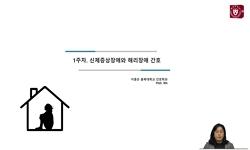목 적: 자해로 응급실에 내원한 환자들은 단순히 자살 행동으로 간주되는 경향이 있다. 하지만 실제로 자살하려는 행동과 의도적 자해 (intentional self-harm, 이하 IHS)는 명확히 구분되어야 할 ...
http://chineseinput.net/에서 pinyin(병음)방식으로 중국어를 변환할 수 있습니다.
변환된 중국어를 복사하여 사용하시면 됩니다.
- 中文 을 입력하시려면 zhongwen을 입력하시고 space를누르시면됩니다.
- 北京 을 입력하시려면 beijing을 입력하시고 space를 누르시면 됩니다.
응급실에 온 의도적 자해 환자들의 정신과적 특성 = Psychiatric Characteristics of Patients with Intentional Self Harm in E.R.
한글로보기https://www.riss.kr/link?id=A108664285
- 저자
- 발행기관
- 학술지명
- 권호사항
-
발행연도
2004
-
작성언어
-
- 주제어
-
KDC
515
-
자료형태
학술저널
-
수록면
3-9(7쪽)
- 제공처
-
0
상세조회 -
0
다운로드
부가정보
국문 초록 (Abstract)
목 적:
자해로 응급실에 내원한 환자들은 단순히 자살 행동으로 간주되는 경향이 있다. 하지만 실제로 자살하려는 행동과 의도적 자해 (intentional self-harm, 이하 IHS)는 명확히 구분되어야 할 필요가 있을 것으로 생각된다. 본 연구의 목적은 의도적 자해를 주증상으로 본원 응급실에 온 환자들의 임상적 특징에 대해 검토하였다. 환자들의 임상적 특징들을 조사하여 자해와 자살의 개념을 명확히 하는데 도움이 되고자 하는 것이다.
방 법:
1995년 1월부터 1998년 12월까지 IHS를 주증상으로 경희대병원 응급실에 내원하여 정신과 진료를 받은 환자 152명(여자 103명, 남자 49명)의 병록지를 토대로 하여 조사하였다. 남녀성비, 연령, 방문계절, 자해도구, 자해부위, 자해정도, 자해동기, 추정 되는 정신과 진단명, 정신과 과거력, 자해 과거력, 응급실 방문 후 치료형태 등으로 드러나는 IHS 특징들을 규명하였다.
결 과:
1) 성비는 2.17:1의 비율로 여자에서 더 빈번하게 나타났다. 환자 연령분포는 남녀 모두 20대가 가장 많았다. 평균 연령은 여자 31.3세, 남자 32.6세였다. 2) 의도적 자해의 가장 흔한 수단은 약물이나 화학물질이었고, 약물 가운데는 정신과에서 처방 받은 약물이 39%로 가장 높았다. 3) 두 번째로 흔한 수단은 손목 절단이었으며, self mutilation의 정도는 대부분 경도, 중등도의 손상 수준이었다. 4) IHS의 가장 흔한 동기는 대인관계나 가정 내 갈등이었다. 5) IHS의 약 54%에서 정신과 질환이 동반되는 것으로 나타났지만, 이들 중 61.2%가 정신과 치료를 받지 못 하였다. 6) IHS의 과거력이 있는 경우는 14.2%였다.
결 론:
IHS는 단순 자살 행동과는 달리 다양한 의미를 내포하고 있고, 성별, 나이 등의 여러 변수에 따라 양상이 다르게 나타났다. 따라서, IHS를 주소로 내원한 환자 진료 시에는 그 개념을 세분하는 것이 필요하며, 자살과는 분화된 개념으로 환자에게 접근하는 것이 필요할 것으로 생각된다.
다국어 초록 (Multilingual Abstract)
Objectives:Patients admitted to the emergency room with self-injurious behavior has been regarded simply as suicidal act. However, it needs to be distinguished bewteen actual suicide and deliberate self harm. Thus, this study was performed to examin...
Objectives:Patients admitted to the emergency room with self-injurious behavior has been regarded simply as suicidal act. However, it needs to be distinguished bewteen actual suicide and deliberate self harm. Thus, this study was performed to examine the clinical characteristics of patients with intentional self harm(ISH).
Methods:The hospital charts of 152 patients(female:103, male:49) with self injurious behavior having evaluated by psychiatrist at the emergency room at Kyunghee University Hospital from January, 1995 to December, 1998. Clinical characteristics of intentional self harm were examined by sex, age, means, injury degree, motive, underlying psychotic disorders, and past history of ISH.
Results:The female to male ratio was 2.17:1. The incidence increases markedly among third decade age group.
Mean age of female patients was 31.3 and 32.6 for males. The most common method for intentional self harm was drugs or chemicals(60%). Among them, drug prescribed in the department of psychiatry was the highest(39%), and the wrist cutting was the second. Regarding the self mutilation, most of them were superficially or moderately injured. The most frequent reason for intentional self harm were interpersonal or intrafamilial conflicts. 54% of patients were supposed to be accompanied with psychiatric disorder, but 61.2% of patients had no history of psychiatric treatment. 14.2% of them also had previous history of intentional self harm.
Conclusion:It is necessary to consider whether it is appropriate to classify ISH as a simple act when no comorbidities are diagnosed. And it is necessary to classify the injurious behavior into suicidal act and self mutilation. Psychiatrists should make different strategies to manage these self injurious patients whenever it is possible.
동일학술지(권/호) 다른 논문
-
일 대학병원에서 치료받은 피해망상을 가진 정신분열병 환자의 박해자
- 대한사회정신의학회
- 김승곤(Seung-Gon Kim)
- 2004
-
- 대한사회정신의학회
- 이준영(Jun-Young Lee)
- 2004
-
- 대한사회정신의학회
- 신윤미(Yun-Mi Shin)
- 2004
-
- 대한사회정신의학회
- 정준규(Joon-Gyu Jeong)
- 2004




 스콜라
스콜라






